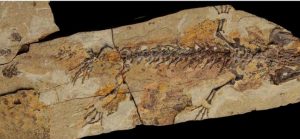
Salamanders are fairly adorable, but often forgotten, animals. Because their skeletons are pretty delicate, the fossil record for this group is spotty, with many ancient forms known only from vertebrae or jaw bones. As has happened for many other vertebrate groups (including birds, mammals, and small dinosaurs), exquisitely preserved fossils from the Mesozoic of China are filling previous gaps in evolutionary history. The latest such salamander discovery was announced today in PLOS ONE.
Qinglongtriton gangouensis is named on the basis of 46 nearly complete skeletons from the Tiaojishan Formation of Hebei Province, China. With such a large sample, the fossils of Qinglongtriton capture many of the details of growth and variation in this animal. For instance, the animal was neotenic–meaning that it retained “juvenile” features such as external gill filaments into adulthood. A parallel example occurs today in axolotls and mudpuppies. Qinglongtriton probably would have been pretty recognizable as a salamander, and at its longest measured around 27 cm from tip to tail (just over 10 inches).
The rocks in which the fossils were discovered date to around 160 million years ago, near the close of the Jurassic Period and just a touch older than famous North American dinosaurs such as Stegosaurus and Brontosaurus. When placed into its evolutionary context, Qinglongtriton ends up as one of the oldest and earliest diverging salamandroids. Salamandroids include everything from mudpuppies to newts to tiger salamanders. They are colloquially known as “advanced salamanders,” for a host of anatomical features that contrast with the primitive condition for amphibians. Their closest relatives are the cryptobranchoids, which include the giant salamanders and others. In conjunction with Beiyanerpeton (another salamandroid from the same rocks as Qinglongtriton), and the Jurassic cryptobranchoid Pangerpeton, the split between the two major groups of modern salamanders can be dated to no later than the Late Jurassic.
So, the fossil record for salamanders is just a little bit better now, and we know more about their history than we did previously. Qinglongtriton and its friends point the way to the potential for even older salamanders–they’re just another expedition away!
Reference:
Jia Jia et al. A New Basal Salamandroid (Amphibia, Urodela) from the Late Jurassic of Qinglong, Hebei Province, China, PLOS ONE (2016). DOI: 10.1371/journal.pone.0153834
Note: The above post is reprinted from materials provided by Public Library of Science.










